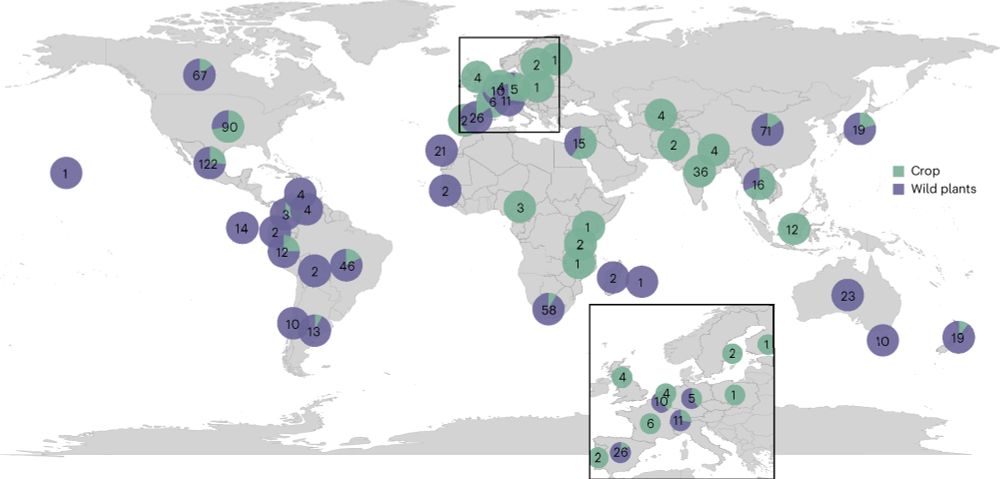Biological modeling is organized inquiry, but how should we think about the process?
My new paper in #EcologyLetters argues that we should model like experimentalists: define treatments, measure responses, validate, perturb, repeat.
👉 doi.org/10.1111/ele....
Do you agree?
06.11.2025 10:36 — 👍 14 🔁 9 💬 3 📌 0
Behavioral variation affects persistence of an experimental food-chain https://www.biorxiv.org/content/10.1101/2025.07.04.663144v1
07.07.2025 23:31 — 👍 1 🔁 1 💬 0 📌 0
All in all, HOIs hardly promote species diversity/coexistence, and trait variation further disrupts it. This goes in saying that maybe for HOI to promote diversity, it should be high-dimensional or have multiple traits mediate it to positively affect coexistence in competitive communities.
28.04.2025 18:52 — 👍 1 🔁 0 💬 0 📌 0
If pairwise competition width is very wide in contrast to the very narrow range at which HOIs come into play, trait-based HOIs can promote diversity than its pairwise counterpart. However, if width of HOI kernel and pairwise are even comparable, HOIs will always reduce species diversity -fig above-
28.04.2025 18:52 — 👍 0 🔁 0 💬 1 📌 0

When does trait-based HOI promote species coexistence? The answer lies in the relative widths of pairwise and HOIs competition, i.e., the width at which pairwise effects dominate versus trait-based HOIs dominate.
28.04.2025 18:52 — 👍 0 🔁 0 💬 1 📌 0
We searched in extensive ways to understand if it is ever possible for trait-based higher order interactions (HOIs) to promote robust coexistence more so than only pairwise competition. The answer is: mostly not, BUT, it is possible under certain scenarios--
28.04.2025 18:52 — 👍 0 🔁 0 💬 1 📌 0
Unreal and unbelievable
09.04.2025 13:19 — 👍 3 🔁 0 💬 0 📌 0
Individualised niches in a variable environment - Consequences for environmental change responses https://www.biorxiv.org/content/10.1101/2025.03.24.644970v1
28.03.2025 02:31 — 👍 1 🔁 1 💬 0 📌 0

Happy to share that the first paper of my PhD is out!
We developed a trait-based framework 🌱🦜 to quantify how plant-frugivore interactions and animal movement shape plant functional connectivity—the dispersal of seeds between habitat patches.
royalsocietypublishing.org/doi/10.1098/...
06.03.2025 16:41 — 👍 29 🔁 14 💬 1 📌 2

PLOS statement on recent US Executive Orders and scientific integrity - The Official PLOS Blog
Since its founding over twenty five years ago PLOS has been dedicated to advancing open science, ensuring that knowledge is accessible to…
PLOS has issued a statement on recent US Executive Orders and scientific integrity.
We are determined to stand firmly behind our mission, our values and our principles, and against any attempt at censorship or undermining of the core principles of scientific inquiry.
plos.io/3D4O8cH
21.02.2025 15:41 — 👍 1100 🔁 430 💬 27 📌 62

🐝🌍 Here, we present #EuPPollNet
EuPPollNet is a fully open-access European database that provides standardized data on plant-pollinator interactions, helping to drive research and guide conservation efforts.
#EBDPub
🔗 onlinelibrary.wiley.com/doi/epdf/10....
10.02.2025 12:43 — 👍 17 🔁 7 💬 0 📌 0

We show that a reduced 2-D model of complex tri trophic food webs can very well capture the recovery dynamics of complete food webs from a collapse state.
06.02.2025 10:20 — 👍 1 🔁 0 💬 0 📌 0

Why I’ve removed journal titles from the papers on my CV
Changing how published papers are displayed could shift the focus from simple metrics to research quality.
Modern scientific publishing puts too much significance on the journal's perceived prestige and not on the quality of the science. This author went so far as to remove journal titles from their CV.
Would you do the same?
#SciPub #AcademicSky 🧪
23.01.2025 17:09 — 👍 38 🔁 7 💬 5 📌 3
Details | Working at Bristol | University of Bristol
🚨We are HIRING! 🧪 Please repost!
Lecturer/Senior lecturer in @bristolbiosci.bsky.social
Priority areas:
‘Responding to anthropogenic change’
‘Reversing the biodiversity crisis’
www.bristol.ac.uk/jobs/find/de...
17.12.2024 12:07 — 👍 66 🔁 64 💬 2 📌 2
A neat blog post by Pragya (not here yet) on how plant "drugs" could impact social interactions of an insects. Behind the paper.
24.11.2024 09:24 — 👍 4 🔁 2 💬 0 📌 0
A neat blog post by Pragya (not here yet) on how plant "drugs" could impact social interactions of an insects. Behind the paper.
24.11.2024 09:24 — 👍 4 🔁 2 💬 0 📌 0

Turnip sawflies use plant chemicals to shape their social lives! Discover how plant metabolites influence insect networks and fitness in a blog by Pragya Singh and colleagues 🪰
https://buff.ly/3Zd7iFz 🧪 🌏
20.11.2024 13:00 — 👍 11 🔁 4 💬 0 📌 1
Ecologist & Evolutionary Biologist.
DPhil @ the University of Oxford 👩🏼🎓 🐝
Postdoc with the Plant Ecology Group at ETHZ❄️ Investigating the density dependent processes impacting tree recruitment 🌳
Professor of Ecology at the University of Georgia. Views are my own.
http://daphnia.ecology.uga.edu/drakelab/
Microbial community ecologist, professor at Michigan State University | Traits, temperature, biodiversity, resilience, microbiomes, harmful algal blooms
https://www.kl-lab.group
📷: Lake Michigan
We use life history theory, experiments & big data to quantify & predict the population dynamics of animals & plants worldwide at @OxfordBiology.bsky.social. PI: @RobSalGo.bsky.social
Professor of Ecology & Conservation. Director of Expertise - Ecosystems in School of Natural and Environmental Sciences @newcastleuni.bsky.social, UK. Researching network ecology/environmental change. Senior Editor
@animalecology.bsky.social. Views my own
Showcasing new research from the publishing portfolio of the Ecological Society of America, the world's largest community of ecologists @ecologicalsociety.bsky.social
Professor of Ecology at Royal Holloway University of London | Forest biodiversity and ecosystem functioning | Plant-herbivore interactions | Methods and applications of meta-analysis in ecology
CSIR Senior Research Fellow, Agricultural and Ecological Research Unit, Indian Statistical Institute, Kolkata | Research in Theoretical Ecology
Ecologist working with species interactions, community dynamics and biodiversity maintenance 🌺🐝🌿
📍Berlin, Germany
Ecologist. Evolutionary Biologist. Woodworker. Homebrewer.
Information about ecological networks, papers and news from the group led by @dmevans.bksy.social at Newcastle University, UK
Senior Lecturer (≡ associate professor) in applied maths, investigating the evolution and ecology of cancer. Dad of two small kids. On sabbatical @isemevol.bsky.social 🇫🇷 (otherwise @citystgeorges.bsky.social 🇬🇧)
robjohnnoble.github.io
Ecologist that studies 🍄🌲🐜🐑🐀🦌🌱🌾🌳🦠⛰, mostly invasives. University of Houston Comahue Senior Editor JAppliedEcology #bioinvasions. Views my own. See my new book! https://mybook.to/ScienceGuide
Cutting-edge research, news, commentary, and visuals from the Science family of journals. https://www.science.org
Associate prof in plant ecology at Uppsala University, Sweden. Tropical forest dynamics, trait-based ecology, natural and anthropogenic disturbance...
Professor of Plant Evolutionary Genetics at Michigan State University.
Senior Researcher at the Netherlands Institute of Ecology (NIOO-KNAW) focused on plant-microbe interactions and drivers of microbial and plant biogeography and ecology
Studying the macro eco-evolutionary dynamics of birds.
https://claramuntlab.org










